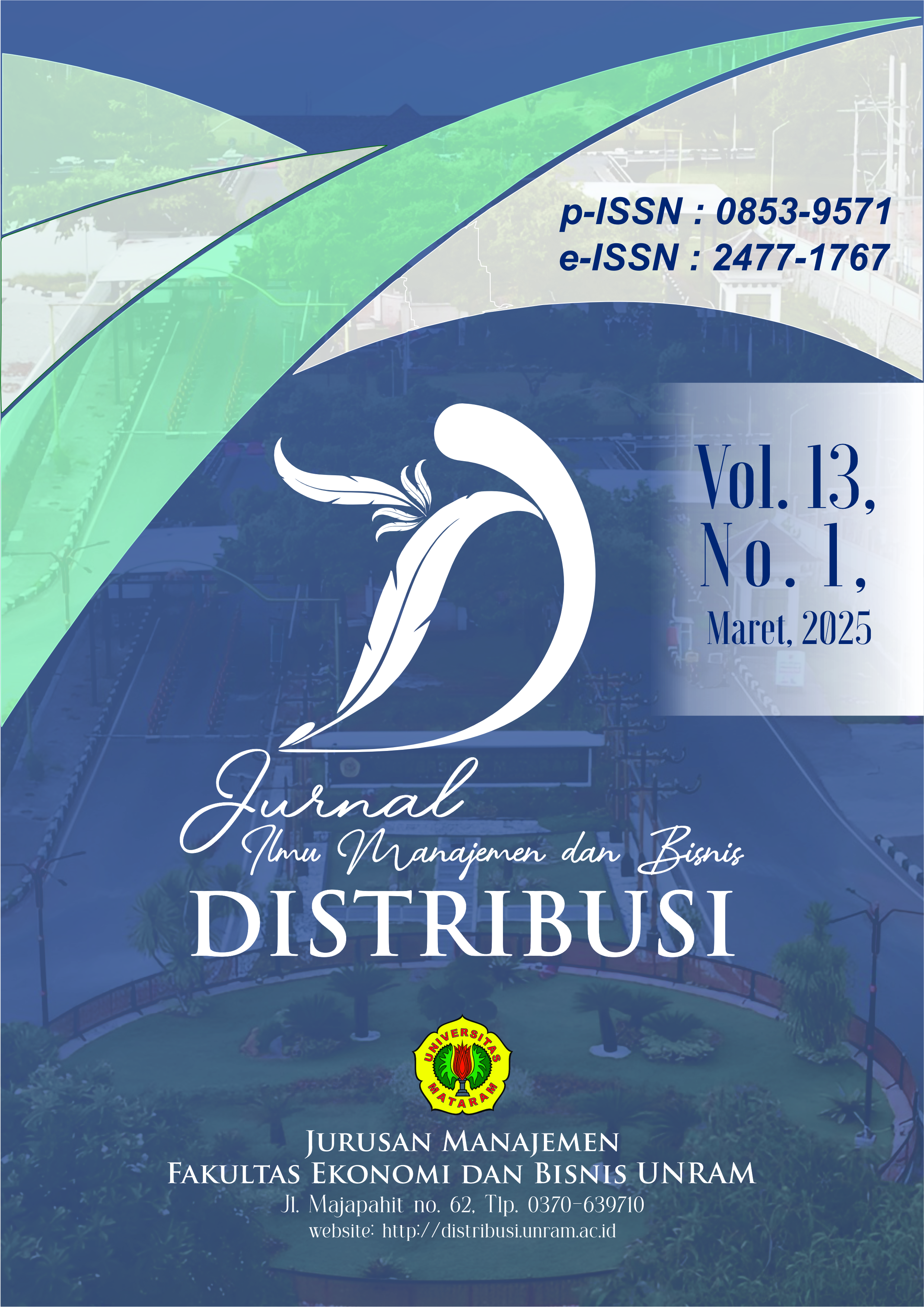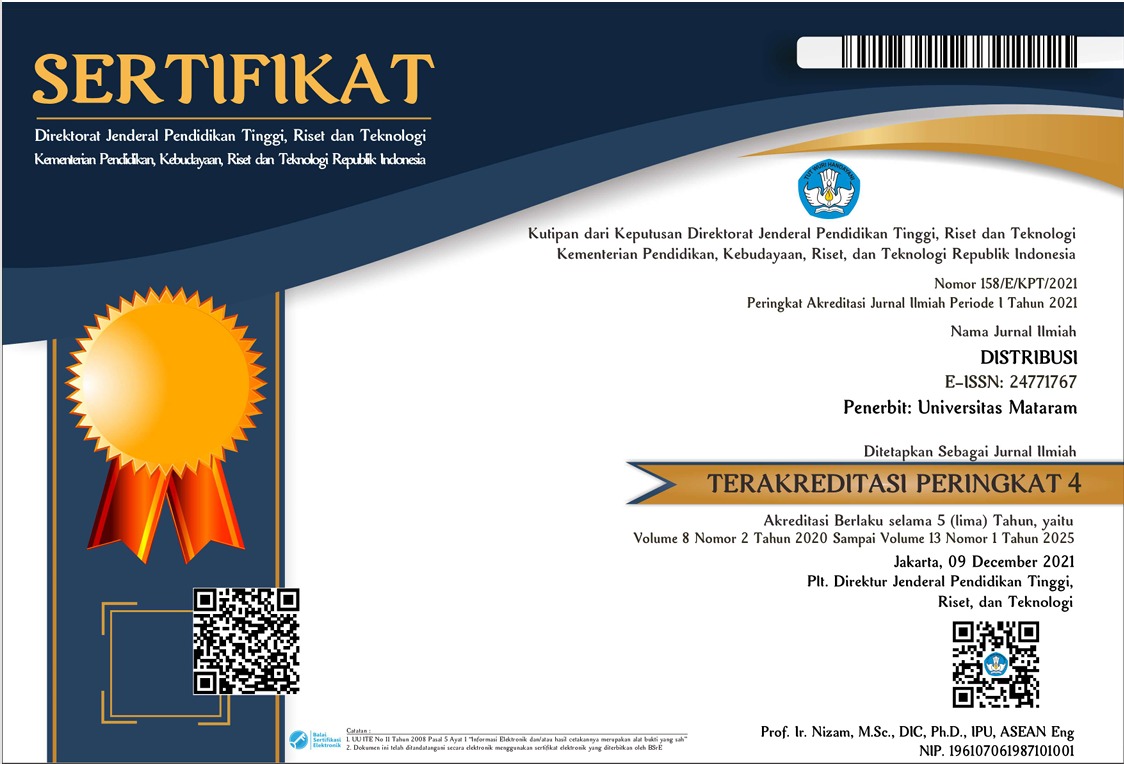MARKETING THROUGH OMNICHANNEL SHOPPING EXPERIENCE TO IMPROVE CUSTOMER CITIZENSHIP BEHAVIOR
DOI:
https://doi.org/10.29303/distribusi.v13i1.610Kata Kunci:
Customer Citizenship Behavior, Customer Engagement, Customer Satisfaction, OmnichannelAbstrak
The growing popularity of mobile devices and the expansion of internet usage have triggered an increase in online purchases. In addition to that, offline purchases and coming directly to the store are also some of the choices of some customers. As the business competition of retail stores in Indonesia increases, customers choose several options for purchasing goods through omnichannel. This research was written to find out more about the effect of marketing through omnichannel shopping experience to increase customer citizenship behavior through customer engagement and customer satisfaction in retail companies in Jabodetabek. This article uses the SEM method and data processing with AMOS. The sampling method uses non-probability sampling with omnichannel shopping customers from the age of 17 years and above. The study results reveal that the personalization factor in omnichannel supports customer engagement and customer satisfaction, both of which are customer citizenship behaviors. This study contributes to the marketing literature by investigating dimensions of omnichannel shopping experience and their impact on customer engagement and customer satisfaction and its also impact on customer citizenship behavior. Furthermore, the study contributes to omnichannel retail stores in Indonesia, especially in the Jabodetabek area.
Unduhan
Referensi
Akgunduz, Y., Nisari, M. A., & Sungur, S. (2023). A roadmap focused on customer citizenship behavior for fast-food restaurants during COVID-19. International Hospitality Review. https://doi.org/10.1108/ihr-01-2023-0006
Ali, S. W., Wani, T. A., & Tyagi, N. (2022). A Qualitative Study on Innovation and Dimensional Aspects of the Omnichannel Retail Business Model. International Journal of E-Business Research, 18(2), 1–20. https://doi.org/10.4018/ijebr.294108
Brodie, R. J., Ilic, A., Juric, B., & Hollebeek, L. (2013). Consumer engagement in a virtual brand community: An exploratory analysis. Journal of Business Research, 66(1), 105–114. https://doi.org/10.1016/j.jbusres.2011.07.029
Chatterjee, S., Chaudhuri, R., & Vrontis, D. (2021). Examining the global retail apocalypse during the COVID-19 pandemic using strategic omnichannel management: a consumers’ data privacy and data security perspective. Journal of Strategic Marketing, 29(7), 617–632. https://doi.org/10.1080/0965254X.2021.1936132
Flavián, C., Gurrea, R., & Orús, C. (2019). Feeling Confident and Smart with Webrooming: Understanding the Consumer’s Path to Satisfaction. Journal of Interactive Marketing, 47, 1–15. https://doi.org/10.1016/j.intmar.2019.02.002
Gerea, C., & Herskovic, V. (2022). Transitioning from Multichannel to Omnichannel Customer Experience in Service-Based Companies: Challenges and Coping Strategies. Journal of Theoretical and Applied Electronic Commerce Research, 17(2), 394–413. https://doi.org/10.3390/jtaer17020021
Gong, T., Wang, C. Y., & Lee, K. (2022). Effects of characteristics of in-store retail technology on customer citizenship behavior. Journal of Retailing and Consumer Services, 65. https://doi.org/10.1016/j.jretconser.2021.102488
Groth, M. (2005). Customers as good soldiers: Examining citizenship behaviors in internet service deliveries. Journal of Management, 31(1), 7–27. https://doi.org/10.1177/0149206304271375
Hair, J. F., Risher, J. J., Sarstedt, M., & Ringle, C. M. (2019). When to use and how to report the results of PLS-SEM. In European Business Review (Vol. 31, Issue 1, pp. 2–24). Emerald Group Publishing Ltd. https://doi.org/10.1108/EBR-11-2018-0203
Hamouda, M. (2019). Omni-channel banking integration quality and perceived value as drivers of consumers’ satisfaction and loyalty. Journal of Enterprise Information Management, 32(4), 608–625. https://doi.org/10.1108/JEIM-12-2018-0279
Hollebeek, L. D. (2011). Demystifying customer brand engagement: Exploring the loyalty nexus. In Journal of Marketing Management (Vol. 27, Issues 7–8, pp. 785–807). https://doi.org/10.1080/0267257X.2010.500132
Huré, E., Picot-Coupey, K., & Ackermann, C. L. (2017). Understanding omni-channel shopping value: A mixed-method study. Journal of Retailing and Consumer Services, 39, 314–330. https://doi.org/10.1016/J.JRETCONSER.2017.08.011
Kang, J. Y. M. (2018). Showrooming, Webrooming, and User-Generated Content Creation in the Omnichannel Era. Journal of Internet Commerce, 17(2), 145–169. https://doi.org/10.1080/15332861.2018.1433907
Kang, J. Y. M. (2019). What drives omnichannel shopping behaviors?: Fashion lifestyle of social-local-mobile consumers. Journal of Fashion Marketing and Management, 23(2), 224–238. https://doi.org/10.1108/JFMM-07-2018-0088
Kim, M., Yin, X., & Lee, G. (2020). The effect of CSR on corporate image, customer citizenship behaviors, and customers’ long-term relationship orientation. International Journal of Hospitality Management, 88. https://doi.org/10.1016/j.ijhm.2020.102520
Kumar, A., & Kim, Y. K. (2014). The store-as-a-brand strategy: The effect of store environment on customer responses. Journal of Retailing and Consumer Services, 21(5), 685–695. https://doi.org/10.1016/J.JRETCONSER.2014.04.008
Lady, Lady, Melsen, F., & Cuandra, F. (2024). Implementing Social Media Marketing Strategy For Micro-Enterprise In Fashion Retail. Distribusi - Journal of Management and Business, 12(2), 243–258. https://doi.org/10.29303/distribusi.v12i2.582
Le, A. N. H., & Nguyen-Le, X. D. (2020). A moderated mediating mechanism of omnichannel customer experiences. International Journal of Retail and Distribution Management, 49(5), 595–615. https://doi.org/10.1108/IJRDM-02-2020-0054
Lee, Z. W., Chan, T. K., Yee-Loong Chong, A., & Thadani, D. R. (2019). Customer engagement through omnichannel retailing: The effects of channel integration quality.
Mosquera, A., Olarte-Pascual, C., Ayensa, E. J., & Murillo, Y. S. (2018). The role of technology in an omnichannel physical store Assessing the moderating effect of gender. Spanish Journal of Marketing - ESIC, 22(1), 63–82. https://doi.org/10.1108/SJME-03-2018-008
Pambudi, A. (2022). The Impact of Omnichannel Retail on Customer Patronage Intentions: The Role of Consumer Empowerment, Service Failure, and Customer Satisfaction. Jurnal Akutansi, Manajemen Dan Ekonomi, Vol. 24 No. 4, 2022, Pp. 21-33, 1–13. http://jos.unsoed.ac.id/index.php/jame
Puspita, D., Sarmigi, E., & Azhar, A. (2024). The Effect Of Product Quality And Price On Loyalty Of Telkomsel Prepaid Card Users With Customer Satisfaction As A Mediating Variable. Distribusi - Journal of Management and Business, 12(2), 271–282. https://doi.org/10.29303/distribusi.v12i2.563
Rahman, S. M., Carlson, J., Gudergan, S. P., Wetzels, M., & Grewal, D. (2022). Perceived Omnichannel Customer Experience (OCX): Concept, measurement, and impact. Journal of Retailing, 98(4), 611–632. https://doi.org/10.1016/J.JRETAI.2022.03.003
Rodríguez-Torrico, P., San, R., Cabezudo, J., San-Martín, S., & Apadula, L. T. (2023). Let it flow: the role of seamlessness and the optimal experience on consumer word-of-mouth in omnichannel marketing. https://doi.org/10.1108/JRIM-06-2021
Rulian, E. P., & Kurniawati, K. (2023). Faktor-Faktor yang Mempengaruhi Kepuasan dan Kepercayaan Terhadap Loyalitas Pelanggan Nasabah Mobile Banking di Indonesia: Studi Tentang Perspektif Kaum Muda sebagai Pengguna. Al Qalam: Jurnal Ilmiah Keagamaan Dan Kemasyarakatan, 17(2), 521. https://doi.org/10.35931/aq.v17i2.2009
Salem, S. F., & Alanadoly, A. B. (2024). Driving customer engagement and citizenship behaviour in omnichannel retailing: evidence from the fashion sector. Spanish Journal of Marketing - ESIC, 28(1), 98–122. https://doi.org/10.1108/SJME-10-2022-0220
Sashi, C. M. (2012). Customer engagement, buyer-seller relationships, and social media. Management Decision, 50(2), 253–272. https://doi.org/10.1108/00251741211203551
Shi, S., Wang, Y., Chen, X., & Zhang, Q. (2020). Conceptualization of omnichannel customer experience and its impact on shopping intention: A mixed-method approach. International Journal of Information Management, 50, 325–336. https://doi.org/10.1016/J.IJINFOMGT.2019.09.001
So-Hyun Bae, & 김동진. (2017). The Impacts of Perceived Service Quality and Restaurant Type on Customer Satisfaction and Return Patronage Intentions: An Exploratory Investigation with a Focus on Solo Diners. Culinary Science & Hospitality Research, 23(1), 84–94. https://doi.org/10.20878/cshr.2017.23.1.010
Sun, Y., Yang, C., Shen, X. L., & Wang, N. (2020). When digitalized customers meet digitalized services: A digitalized social cognitive perspective of omnichannel service usage. International Journal of Information Management, 54, 102200. https://doi.org/10.1016/J.IJINFOMGT.2020.102200
Sung, E. (Christine), Bae, S., Han, D. I. D., & Kwon, O. (2021). Consumer engagement via interactive artificial intelligence and mixed reality. International Journal of Information Management, 60, 102382. https://doi.org/10.1016/J.IJINFOMGT.2021.102382
Tuti, M., & Sulistia, V. (2022). The Customer Engagement Effect on Customer Satisfaction and Brand Trust and Its Impact on Brand Loyalty. Jurnal Manajemen Bisnis, 13(1), 1–15. https://doi.org/10.18196/mb.v13i1.12518
Vivek, S. D., Beatty, S. E., Dalela, V., & Morgan, R. M. (2014). A generalized multidimensional scale for measuring customer engagement. Journal of Marketing Theory and Practice, 22(4), 401–420. https://doi.org/10.2753/MTP1069-6679220404
Wantara, P., & Tambrin, M. (2021). Hubungan Struktural Kualitas Layanan, Kualitas Produk, Kepuasan Pelanggan, Dan Niat Ulang Berkunjung Ke Pantai Long Malang Di Sampang (Vol. 9, Issue 2).
##submission.downloads##
Diterbitkan
Cara Mengutip
Terbitan
Bagian
Lisensi
Hak Cipta (c) 2025 Geri Ghazian, Yolanda Masinta, Kurniawati Kurniawati

Artikel ini berlisensiCreative Commons Attribution-ShareAlike 4.0 International License.
Penulis yang mengirimkan naskah harus memahami dan menyetujui bahwa jika diterima untuk dipublikasikan, hak cipta dari artikel adalah milik Distribusi. Hak cipta (copyright) meliputi hak eksklusif untuk mereproduksi dan memberikan artikel dalam semua bentuk dan media, termasuk cetak ulang, foto, mikrofilm dan setiap reproduksi lain yang sejenis, serta terjemahan. Distribusi, Fakultas Ekonomi dan Bisnis Universitas Mataram, dan Editor melakukan segala upaya untuk memastikan bahwa tidak ada data, pendapat atau pernyataan yang salah atau menyesatkan yang dipublikasikan di jurnal ini. Isi artikel yang diterbitkan di Distribusi adalah tanggung jawab tunggal dan eksklusif dari masing-masing penulis.








